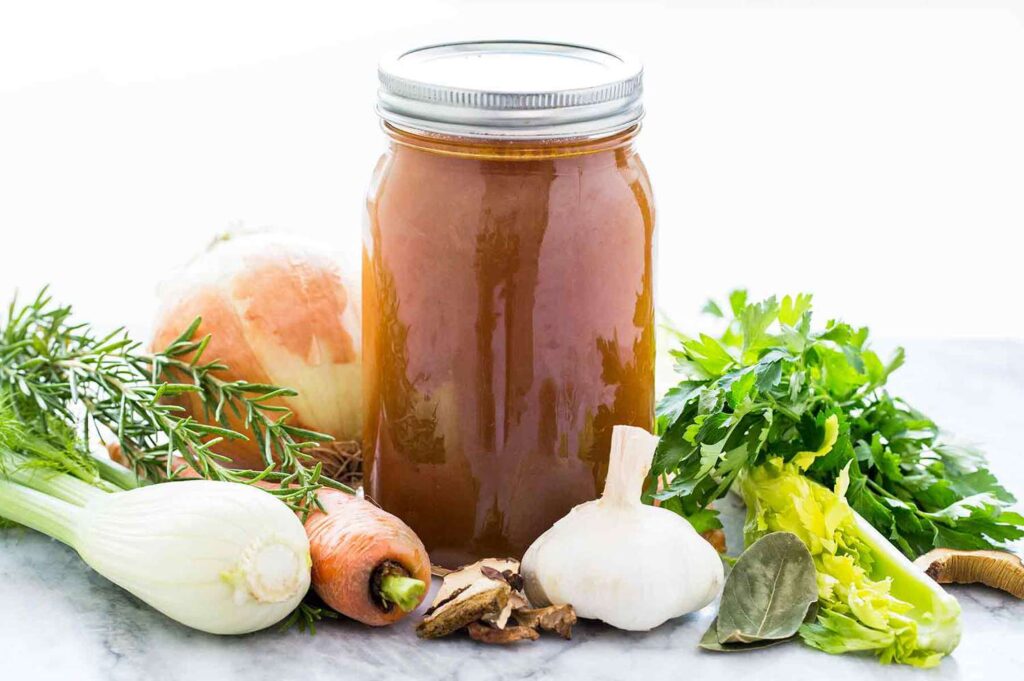In the symphony of flavors that dances across our palates, there are unsung heroes, foundational elements that quietly contribute depth and complexity to countless dishes. Among these culinary cornerstones lies brown vegetable stock, a rich and aromatic elixir that elevates everything it touches. Far beyond a simple collection of vegetable scraps simmered in water, brown vegetable stock is a testament to the transformative power of slow, deliberate cooking, unlocking hidden sweetness and savory notes that its paler counterpart simply cannot achieve.
For the passionate home cook and the seasoned professional chef alike, understanding and mastering the art of brown vegetable stock is akin to possessing a secret weapon. It’s the bedrock upon which magnificent soups, vibrant sauces, flavorful braises, and nuanced risottos are built. It’s the silent contributor to that indescribable je ne sais quoi that makes a dish truly exceptional.
But why brown vegetable stock? What distinguishes it from its lighter, more ubiquitous sibling? The answer lies in a single, yet profound, culinary technique: roasting. This seemingly simple step unlocks a cascade of flavor transformations within the vegetables, caramelizing their natural sugars and developing deep, savory umami notes that infuse the resulting stock with unparalleled richness.
Imagine the humble onion, its sharp bite mellowing and sweetening under the gentle heat, its golden edges whispering promises of concentrated flavor. Picture the earthy carrots, their inherent sweetness intensifying, their vibrant orange hue deepening to a warm, inviting amber. Envision the celery, its crispness yielding to a tender texture, its aromatic essence becoming more pronounced and complex.
This is the magic of roasting – it’s not merely about cooking the vegetables; it’s about coaxing out their hidden potential, transforming them from simple ingredients into building blocks of profound flavor. This process creates a stock that is not just watery vegetable essence, but a concentrated infusion of roasted goodness, a liquid embodiment of earthy sweetness and savory depth.

Beyond the Basics: Unveiling the Nuances of Flavor
While the core principle of brown vegetable stock revolves around roasting, the journey to creating a truly exceptional batch involves a deeper understanding of flavor profiles and ingredient selection. Just as a painter carefully chooses their pigments to create a masterpiece, a discerning cook thoughtfully selects vegetables that will contribute harmoniously to the final stock.
The classic trio of onions, carrots, and celery, often referred to as mirepoix, forms the aromatic foundation of most stocks, and brown vegetable stock is no exception. However, venturing beyond these staples can unlock exciting new dimensions of flavor. Consider adding:
- Mushrooms: These earthy fungi, particularly varieties like cremini or shiitake, contribute a deep, umami richness that elevates the savory profile of the stock. Roasting them intensifies their inherent meatiness, adding a satisfying depth.
- Leeks: With their milder, sweeter onion-like flavor, leeks add a delicate complexity to the stock. Ensure they are thoroughly cleaned to remove any hidden grit.
- Parsnips: These often-overlooked root vegetables offer a subtle sweetness and a slightly peppery note that complements the other vegetables beautifully.
- Garlic: Roasted garlic cloves impart a mellow, sweet, and deeply aromatic flavor that can add a delightful layer of complexity.
- Tomatoes: A few halved tomatoes, roasted alongside the other vegetables, contribute a subtle acidity and a touch of sweetness, adding brightness and depth to the stock.
Beyond the vegetables themselves, the inclusion of aromatics further enhances the complexity of brown vegetable stock. Herbs like bay leaves, thyme, and parsley stems release their fragrant oils during the simmering process, adding subtle yet crucial layers of flavor. A few peppercorns can introduce a gentle warmth, while a Parmesan rind (often reserved from grating) can contribute a surprising depth of savory richness (ensure it’s from a vegetarian-rennet cheese for a purely vegetable stock).
The key is to understand how different ingredients interact and complement each other. A well-crafted brown vegetable stock is not just a random assortment of vegetables; it’s a carefully balanced blend of flavors that work in synergy to create a truly exceptional base.
The Art of the Roast: Achieving Deep, Complex Flavors
The roasting process is where the magic truly happens. It’s not enough to simply toss the vegetables onto a baking sheet; attention to detail is crucial for achieving the desired depth of flavor.
- Preparation is Key: Cut the vegetables into roughly equal-sized pieces to ensure even roasting. A light toss with a neutral oil, such as olive or vegetable oil, helps to promote browning and prevent sticking. Avoid overcrowding the baking sheet, as this will steam the vegetables rather than roast them. If necessary, roast in batches.
- Embrace the Brown: The goal of roasting is to achieve a deep, golden-brown color on the vegetables. This caramelization is what unlocks the complex sugars and savory compounds that define brown vegetable stock. Don’t be afraid of a little charring, but avoid burning, which can impart a bitter taste.
- Temperature and Time: A moderate oven temperature, typically between 375°F (190°C) and 400°F (200°C), is ideal for allowing the vegetables to roast slowly and evenly. The roasting time will vary depending on the vegetables and their size, but typically ranges from 30 to 60 minutes. Keep a close eye on them and remove them from the oven when they have reached a rich, deep brown color.
Once the vegetables are beautifully roasted, the simmering process gently extracts their concentrated flavors into the water. Using cold water to start helps to gradually draw out the flavors. Simmering over low heat for a sufficient amount of time, typically 1 to 2 hours, allows the flavors to fully develop and meld together. Avoid a rolling boil, which can emulsify impurities and result in a cloudy stock.
The Versatility of Brown Vegetable Stock: A Culinary Workhorse
Brown vegetable stock is far more than just a base for soup. Its rich and savory character makes it an invaluable ingredient in a wide range of culinary applications:
- Soups and Stews: It provides a deeply flavorful foundation for hearty vegetable soups, creamy bisques, and robust stews, adding layers of complexity that water or lighter stocks simply cannot replicate.
- Sauces and Gravies: Brown vegetable stock forms the basis for luscious pan sauces, vibrant reductions, and flavorful vegetarian gravies, lending depth and richness to every spoonful.
- Braising Liquids: When braising vegetables or vegetarian proteins, brown vegetable stock infuses them with savory goodness, creating tender and flavorful results.
- Risotto and Grains: Using brown vegetable stock to hydrate risotto rice or other grains adds a profound depth of flavor, transforming a simple side dish into a culinary delight.
- Deglazing: After sautéing vegetables or plant-based proteins, a splash of brown vegetable stock can deglaze the pan, lifting flavorful browned bits and creating the foundation for a delicious sauce.
- Flavor Enhancer: Even a small amount of concentrated brown vegetable stock can be added to vegetarian chili, pasta sauces, or vegetable gratins to boost their savory complexity.
The possibilities are truly endless. Once you have a batch of homemade brown vegetable stock on hand, you’ll find yourself reaching for it time and time again to elevate your culinary creations.
The Benefits of Homemade: Quality, Control, and Flavor
While commercially available vegetable broths and stocks exist, crafting your own brown vegetable stock offers significant advantages:
- Unparalleled Flavor: Homemade stock, made with freshly roasted vegetables and quality aromatics, boasts a depth and complexity of flavor that store-bought options simply cannot match. You control the ingredients and the intensity of the flavors.
- Control Over Ingredients: By making your own stock, you can ensure it is free from unwanted additives, excessive sodium, and artificial flavors that are often found in commercial products. This is particularly important for those with dietary restrictions or a preference for natural ingredients.
- Sustainability: Utilizing vegetable scraps that might otherwise be discarded, such as onion peels, carrot tops, and celery ends (as long as they are clean and not bitter), is a sustainable and economical way to create flavorful stock.
- Customization: You have the freedom to customize the flavor profile of your stock by experimenting with different vegetables, herbs, and aromatics to suit your specific culinary needs and preferences.
Making brown vegetable stock is an investment in flavor. While it requires a bit of time and effort, the resulting liquid gold will undoubtedly elevate your cooking to new heights. The deep, savory notes and aromatic complexity will transform your dishes, adding a layer of richness and satisfaction that is truly remarkable.
How to Make Brown Vegetable Stock

Brown Vegetable Stock is a flavorful liquid base made by roasting vegetables until deeply caramelized, then simmering them with water and aromatics. This roasting process unlocks a rich, savory, and slightly sweet flavor profile that distinguishes it from lighter vegetable stocks. It's a versatile ingredient used to enhance the depth and complexity of soups, sauces, braises and other culinary creations
- 300 g Onions
- 300 g Carrots
- 300 g Celery
- 300 g Leeks
- 180 ml Sunflower oil
- 150 g Tomatoes
- 150 g Mushroom trimmings
- 18 Peppercorns
- 4 litres Water
- 15 g Yeast extract
- Cut the Vegetables into mirepoix. Fry the mirepoix in the oil oil until golden brown
- Drain and place in a suitable sauce pan. Add all the other ingredients except the yeast extract and water
- Cover with water and bring to the boil
- Add the yeast extract and simmer gently for approximately 1 hour. Then skim if necessary and use
Variation
Brown fungi stock: Add 200 – 400g open or field mushroom, Stalks and trimming (all well washed) to the recipe
Embracing the Journey: From Humble Vegetables to Culinary Gold
The creation of brown vegetable stock is a testament to the transformative power of simple ingredients and mindful cooking techniques. It’s a journey that begins with humble vegetables, coaxed to release their hidden sweetness and savory depths through the magic of roasting. Slowly simmered with fragrant aromatics, these roasted vegetables yield a liquid essence that is far greater than the sum of its parts – a culinary cornerstone that adds depth, complexity, and unparalleled flavor to a multitude of dishes.
By understanding the nuances of ingredient selection, mastering the art of the roast, and appreciating the versatility of this flavorful elixir, you unlock a secret weapon in your own kitchen. Brown vegetable stock is not just a recipe; it’s a foundation, a building block, and a testament to the profound impact that thoughtfully prepared, simple ingredients can have on the art of cooking. So, embrace the journey, savor the aromas, and discover the deeply satisfying world of homemade brown vegetable stock – your palate will thank you.
In essence, brown vegetable stock is a testament to the transformative power of simple ingredients treated with care. Its deeply savory and subtly sweet character makes it an invaluable asset in any kitchen, capable of elevating a wide array of dishes from the everyday to the extraordinary.
If you’re eager to explore more foundational techniques and discover exciting ways to build flavor in your cooking, be sure to check out the other recipes and culinary insights on my website. There’s a whole world of delicious possibilities waiting to be unlocked!
